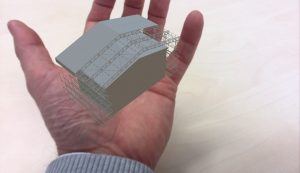Reach greater heights with technology

The benefits of technology are clear to see: it streamlines delivery, reduces risk and drives productivity across a project’s supply chain. Whether it is BIM, virtual/augmented reality or IoT (Internet of Things), digital solutions are reinventing the wheel of construction and are streamlining project delivery in ways that once belonged only to a distant future.
With technology very much a reality in today’s construction world, in this blog I will unpick the current and future technologies that are making a difference to the temporary works sector; beginning with the process that is enabling greater consistency across building design and management: Building Information Modelling (BIM).
BIM
BIM is giving a project’s entire supply chain improved visibility when it comes to planning, designing and managing built assets. From enabling architects to design-out risk, to providing contractors with the capability to digitise construction sites, this intelligent 3D model is optimising work processes and collaboration in a notoriously disjointed industry. Not only is it bringing the construction industry into the modern age, BIM is also improving the levels of safety in which buildings are made and maintained. In a post-Grenfell society, this factor is of the highest regard.
For the temporary works industry, BIM is enabling internal and external design engineers to produce complex 3D scaffolding blueprints for simple structures. Unlike 2D CAD drawings, 3D modelling produces detailed designs in far less time and with more reliability. Designers can reap these benefits with the HAKI Design Tool and HAKI BIM; two solutions in which the former enables designers to configure scaffolding designs on a cloud-based platform – Inventor iLogic and Configurator 360 from Autodesk – and the latter advances this configuration onto Revit for greater customisation and capability, particularly when it comes to interacting with the components within the 3D model.
As BIM progresses, the industry will see the wider adoption of 4D, 5D and 6D iterations. HAKI is currently engaging in 6D BIM on Hinkley Point C (HPC), the UK’s newest nuclear power site. This version is processing live connections to the sites to inform decision-making. Each week a site is scanned for updates, where this data is assimilated and then disseminated to the project’s supply chain so weekly progressions can be viewed. With 6D BIM, the HPC project’s supply chain has full visibility of a project, which is currently the largest construction site in Europe!
Augmented reality
On construction projects, virtual or augmented reality (VR/AR) gives a clear visualisation of how a project will function in real-life. A project’s 3D BIM model is loaded onto the AR software, to give full visibility of the components. Users can then interact and walk through the ‘project world’ to review the work prior to construction.
HAKI has developed a version of such software named HAKI Playground, which allows users to walk around the project directly on-screen. This can be used on any device including a PC, tablet, smartphone, Xbox and PlayStation.
After a project has been completed in Revit or HAKI BIM, it can be exported to the gaming platform, Unity. An avatar lets the user walk around the project as if it was in the real world. The user can, for instance, see the detail of a scaffolding beam and analyse its compatibility with fellow materials, enabling money to be saved and risk to be mitigated on projects. To provide even greater accessibility, the HAKI App is making use of smartphone technology to enable its customers to view products in AR, in order to find information quickly.
As well as being suitable for a number of devices, HAKI Playground negates the need for any headsets with glasses – a real bonus for those constantly moving around a project. The application also allows a number of stakeholders in the supply chain to experience the solution in VR at any one time and is not restrictive to one person, unlike most other applications. This is particularly beneficial for group environments and collaborative or collective feedback.
The ‘Internet of Things’ (IoT)
The ‘Internet of Things’ basically encompasses every and any object which uses the internet to connect with another ‘thing’. Smartphones, Fitbits, Amazon Echo, each household has at least one of these objects (which are in constant dialogue with another). For the construction industry, the IoT has radically changed the way projects are managed and built; there are apps for project management, deliveries, timesheets etc. IoT is essentially allowing important decisions to be made anytime, anywhere, freeing up site-workers from the shackles of their office computers so work can be performed in any location with decent Wi-Fi.
BIM, AR and IoT technologies are just a few of the innovations which are providing the answers to the construction industry’s biggest grievances. Preventing risk, streamlining project delivery and assuring safety, it won’t be long until construction’s digital future becomes a firm reality.
 Haki has now acquired vertemax – Discover the
Haki has now acquired vertemax – Discover the 